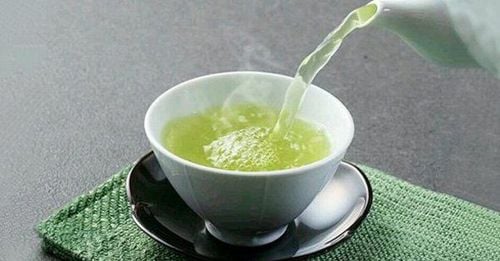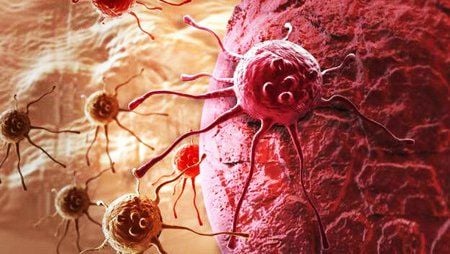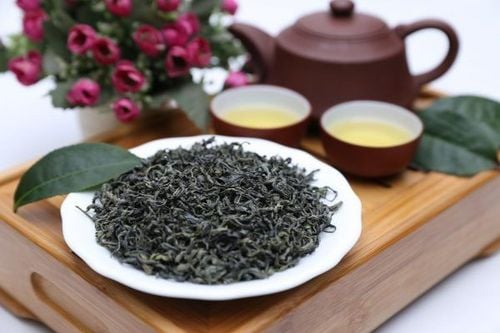This is an automatically translated article.
Long ago, drinking tea is considered a traditional beauty of Asians. Today, it is also widely available in many parts of the world and is known as a powerful cancer prevention drink.
1. What is tea?
Tea is one of the ancient drinks and it is still very popularly consumed around the world today. According to statistics, black tea accounts for about 75% of the tea consumed in the world. In the United States, United Kingdom (UK) and Europe, black tea is the most widely used tea, with green tea being the favorite of the Japanese and Chinese. Some other teas such as oolong tea and white tea are consumed in smaller quantities than other teas.
Tea is made from the dried leaves of the Camellia sinensis plant. Tea leaves will start to become wilted and oxidized only a short time after harvest. In the process of oxidation, enzymes will perform the task of breaking down the chemicals in the tea leaves, which is also the reason why the leaves are dark in color and have a characteristic aroma.
Only when you heat these tea leaves will the oxidation process stop, because hot water will inactivate the enzymes. Normally, black tea will be produced when the tea leaves have been wilted, rolled and fully oxidized.
In contrast, green tea is made from undried tea leaves that are only partially oxidized. For oolong tea, it is made from wilted, crushed and partially oxidized tea leaves. Another less common type of tea is white tea, which is made from young tea leaves or buds that have undergone a certain oxidation process.
Tea in filter bag or liquid form is usually brewed from leaves and dried buds. They are made from an instant dry tea blend or are sold as ready-to-drink teas. This type of tea is often referred to as herbal tea. It is not a real tea but is prepared with dried fruit, herbs or flowers.

Trà là một trong những loại thức uống phổ biến hiện nay
2. The main ingredients of tea
Tea contains many essential components, including alkaloids (caffeine, theophylline and theobromine), polyphenols, carbohydrates, amino acids, fluoride, proteins, volatile organic compounds (chemicals that produce vapors and contribute to tea flavor), chlorophyll, minerals, aluminum and trace elements. In particular, tea polyphenols also contain a large group of phytochemicals, especially catechins. This chemical is essential for health and is most abundant in green tea (epigallocatechin-3-gallate (EGCG)). Below are the respective concentrations of catechins in green tea extract.
3. Concentration of catechins in green tea essence
| Catechin trong dịch truyền trà xanh | Nồng độ catechin (mg / L) | Nồng độ catechin (mg / 8 fl oz) |
| Epigallocatechin-3-gallate (EGCG) | 117–442 | 25–106 |
| Epigallocatechin (EGC) | 203–471 | 49–113 |
| Epicatechin-3-gallate (ECG) | 17–150 | 4–36 |
| Epicatechin (EC) | 25–81 | 6–19 |
*Note: mg = milligrams; L = liters; fl oz = fluid ounce
Black tea generally contains much lower concentrations of catechins than green tea. The prolonged oxidation of black tea resulted in increased concentrations of thearubigins and theaflavins, two complex polyphenols. Oolong tea contains a mixture of simple polyphenols, such as catechins and complex polyphenols.
Although ready-to-drink tea and iced tea are becoming popular beverages worldwide, they do not have the same polyphenol content when brewed with equal amounts of tea. In general, the polyphenol concentration of any tea-based beverage will depend on the type of tea, the dose used, the brewing time, and the temperature. Hot brewed tea usually contains the highest concentration of polyphenols.
On the other hand, when the percentage of solids of tea, including dried tea leaves and buds, is reduced, the amount of polyphenols also decreases. Ready-to-drink teas are generally lower in solids and tea polyphenols. Adding other liquids, such as juice, will further dilute the solids of the tea. In addition, decaffeination also causes the catechin content in tea to decrease.

Catechin trong tinh chất trà xanh đem lại giá trị nhất định cho sức khỏe con người
4. How can tea help prevent cancer?
Polyphenols in green tea include many compounds such as EGCG, ECG, EGC and EC. Black tea also contains substances with antioxidant activity, such as thearubigin and theaflavins. These chemicals, especially ECG and EGCG, have the ability to prevent harmful free radicals and protect cells from DNA damage caused by reactive oxygen species.
Moreover, tea polyphenols have also been shown to inhibit tumor cell proliferation, counteract damage caused by ultraviolet (UVB) radiation, and regulate the functions of tumor cells. of the body's immune system. Many studies also show that the catechins in tea have the effect of preventing angiogenesis and invasion of cancer cells. In addition, green tea also has the effect of activating anti-reading enzymes, such as quinone reductase and glutathione S-transferase, thereby protecting and against the growth of cancerous tumors.
5. Tea's Antioxidants and Cancer Prevention
The human body continuously produces oxidants, also known as free radicals. These are unstable molecules, so to become more stable, free radicals will "steal" electrons from other molecules. This damaged the genetic material and protein cells in the body. It is this damage that increases the risk of cancer of the cells.
On the other hand, antioxidants are substances that help the body filter and capture harmful oxidants. Similar to other antioxidants, catechins present in tea act as a selective inhibitor of carcinogenic enzyme activities. In addition, they also contribute to the repair of DNA errors caused by free radicals.
As mentioned above, all teas come from the leaves of an evergreen plant called Camellia sinensis. In general, green tea often contains higher levels of antioxidants than black tea because they undergo less processing.
Some studies have found that, when you steep or brew green/black tea with hot water for five minutes, it releases around 80% more catechins. However, the amount of catechins in iced tea is usually negligible.
Other laboratory studies have shown that the catechins present in tea act as a powerful inhibitor of cancer growth. They help eliminate free radicals before causing cell damage, while reducing the rate and size of tumors caused by chemicals, thereby inhibiting the growth of cancer. The antioxidants present in tea are thought to prevent some of the following cancers: oral cancer, oropharyngeal cancer, prostate cancer, stomach cancer, colorectal cancer, and breast cancer. , ovarian cancer , lung cancer or skin cancer .

Catechin của trà xanh có khả năng ngăn ngừa ung thư
6. Safety considerations when drinking tea
Tea is a food that has been recognized as safe by the US Food and Drug Administration. However, consuming up to 1200 mg of supplemental EGCG in healthy adults over a certain period of time can lead to some unwanted side effects. These include nausea, excess gas in the intestines, heartburn, upset stomach, upset stomach, headache, dizziness, and muscle aches.
In addition, the high amount of caffeine in tea products can lead to conditions such as palpitations, tachycardia, nausea, vomiting, insomnia, headache, stomachache, tremor, anxiety, diuresis and diarrhea. Therefore, it is recommended for healthy adults to consume a moderate amount of caffeine, equivalent to about 300-400 mg per day to prevent possible side effects.
On the other hand, the amount of caffeine in each tea also varies, with black tea usually containing the highest amount of caffeine (ranging from 64 - 112 mg per fl oz serving), and oolong tea containing about 29 - 53 mg per 8 fl oz serving. Green tea and white tea typically contain less caffeine than other teas, ranging from 24-39 mg and 32-27 mg per 8-fl oz serving, respectively.
In children, too much caffeine in tea or other beverages, such as coffee or cola, can lead to a number of behavioral effects, such as anxiety, stress and sleep disturbances.
Tea also contains aluminum, an element that is toxic to nerves. Studies have found that aluminum concentrations in green and black tea extracts range from 14 to 27 micrograms/liter (μg/L), and 431 to 2239 μg/L. body can lead to osteomalacia and neurodegenerative disorders, especially in people with kidney failure.
People with iron-deficiency anemia also need to be especially careful when drinking tea, as black and green tea can inhibit the bioactivity of dietary iron. However, you can still minimize this interaction by adding iron-boosting foods, such as red meat (which provides heme iron) and foods rich in vitamin C ( eg lemon). In addition, you should not drink tea with meals because it can affect the body's absorption of iron.
Please dial HOTLINE for more information or register for an appointment HERE. Download MyVinmec app to make appointments faster and to manage your bookings easily.
Articles referenced sources: cancer.gov, wiki.cancer.org.au, medicinenet.com, ncbi.nlm.nih.gov












